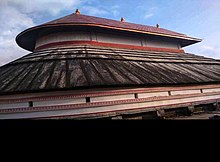Udupi Anantheshwara Temple is a Hindu temple dedicated to Ananteshwara Parashurama (an avatar of Vishnu). The Anantheshwara temple is located in Udupi, India. The temple is a unique temple where Parashurama is worshipped in the form of Linga.[1][2] Writer Roshen Dalal says, "According to texts, the city formed part of Parashurama Kshetra, the area is said to be claimed by Parashurama from the sea. Legends state that a king named Ramabhoja worshipped Parashurama here in the form of Linga, which then manifests on a silver seat (rajata pitha). Thus in Sanskrit texts, the city is known as Rajata Pitha".[3] Madhva Brahmins are priests in this temple. They have been following poojas and rituals in the temples as per Madhva Sampradaya and Tantra Sara Sangraha written by Madhvacharya for the past 700 years.[4]
| Anantheshwara Temple of Udupi | |
|---|---|
 | |
| Religion | |
| Affiliation | Hinduism |
| District | Udupi district |
| Deity | Ananteshwara Parashurama (Vishnu) |
| Location | |
| Location | Udupi |
| State | Karnataka |
| Country | India |
| Architecture | |
| Type | Kerala temple architecture |
The temple was built during the reign of the Alupas in the 8th century C.E. and is considered among the oldest in the Tulu Nadu region. The Ananteshwara Temple is close to Chandramouleshwara Temple of Shiva.
The temple is the oldest in Udupi managed by Puttige Matha, one of the Ashta Mathas of Udupi.[5] This is the place where Madhvacharya wrote many of his Tattvavada scripts, taught it to his disciples and got adrushya (disappeared) to Badari to stay along with Vedavyasa.[6][7]
References
- ^ G. Kameshwar (2004). Tulu Tales: A Soota Chronicle. Rupa & Company. p. 31. ISBN 9788129104274.
The association of Parasurama, an incarnation of Vishnu, with the Linga, came to be known as Anantheshwara and the place of worship is the present Anantheshwara temple.
- ^ "Steeped in history, the region is a pilgrim's delight". The Hindu. Retrieved 18 April 2015.
- ^ Roshen Dalal (18 April 2014). Hinduism: An Alphabetical Guide. Penguin UK. p. 1267. ISBN 9788184752779.
- ^ Pratyush Shankar (24 June 2024). Potency of the Vernacular Settlements: Recent Scholarships in Vernacular Studies. Taylor & Francis. p. 453. ISBN 9781040132913.
- ^ "Udupi: Internal differences between Swamijis of eight Maths pour out into open". Daijiworld News. 10 June 2015.
- ^ Keshavadas (1972). The Doctrine of Reincarnation and Liberation. Dasashrama Research Publications. p. 77.
It also creates awe and wonder to know that Madhwa disappeared in the air from Udipi Ananteshwara Temple while he was lecturing on the Aitaraya Upanishad which is why it is known that he was the incarnation of the wind god.
- ^ C. Panduranga Bhatta; G. John Samuel (1997). Contribution of Karaṇāṭaka to Sanskrit. Institute of Asian Studies. p. 352.